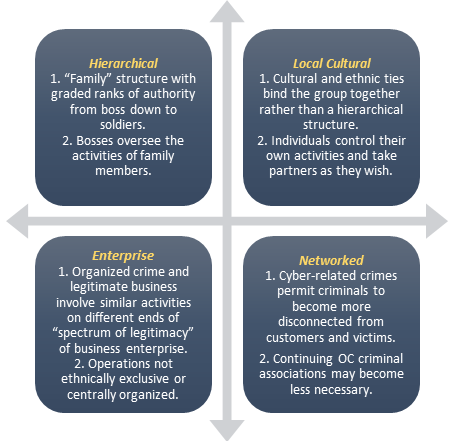- Models and structure of organized crime
- Hierarchical model of organized criminal groups
- Local, cultural model of organized crime
- Enterprise or business model of organized crime
- Focusing on groups versus activities
- New forms of organized crime: networked structures
- Summary
- References
Published in May 2018
Regional Perspective: Pacific Islands Region - added in November 2019
Regional Perspective: Eastern and Southern Africa - added in April 2020
This module is a resource for lecturers
New forms of organized crime: networked structure
A newer structure of organized crime occurs in the virtual world of cyberspace. Cyberspace is the electronic marketplace in which illicit goods and services are sold, and businesses sometimes infiltrated, without physical contact between the supplier and customer.
Organized criminal groups use digital services but also run digital services, both for financial or other material benefit. (Broadhurst, Grabosky, Alazab, Bouhours, Chon, 2014; Choo and Smith, 2008) Hackers threaten and extort victims, illicit drugs are sold and purchased online, as are falsified medical products, counterfeit merchandise, illicit wildlife specimen and stolen property. The Internet and the Darknet provide virtual spaces that can be used to connect criminals to customers without physical contacts. Are structured organized criminal groups necessary for these offenders?
Criminals associate when it is necessary to operate a criminal scheme. If cyber-related crimes permit criminals to become more disconnected from customers and victims, will members of organized criminal groups become more disconnected from each other? Continuing criminal associations may become less necessary. Instead, networks of convenience emerge in which criminals associate, perhaps temporarily, and only when it is necessary to do so. These circumstances might involve the need to find members with certain skills or access to supply, customers or competitors (Brenner, 2002).
|
Organized crime 2.0 Contemporary organized crime may be moving away from longer-term traditional relationships and structures to more fluid, less formal and temporary associations. For example, Europol reported that approximately 20% of known criminal networks in the EU exist for only a short time and are set up to support specific criminal schemes (Europol, 2017). |
The less formal, more fluid nature of some contemporary organized criminal groups may reflect a wider characteristic in society in general, where long-term personal relationships diminish, reducing personal loyalty and commitment among individuals and institutions. In the world of organized crime, this is a further argument to distinguish the acts of organized criminal groups from the offenders who engage in it. The illicit acts committed by organized criminal groups have remained quite stable, reflecting changes in the opportunities to provide illicit goods and services. These changes in opportunities occurred through globalization of commerce and technological advances, e.g., broad Internet access and remote banking. On the other hand, the structure of organized criminal groups may reflect changes in the nature of relationships needed to be successful in the criminal marketplace. Figure 7.1 illustrates the similarities and differences among the different models of organized criminal groups.
Figure 7.1. Models of Organized Criminal Groups

Regional perspective: Pacific Islands RegionCriminal Organizations in the Pacific"Little is known about the types and structure of criminal organisations active in the South Pacific and their level of sophistication. Most available sources point to Asian crime gangs, especially Chinese and Japanese. The yakuza appears to be particularly influential in Guam, and the former US territories of Micronesia and Northern Marianas. According to reports by the US Federal Bureau of Investigations (FBI), the yakuza maintains links to local businesses and politicians in these places and engages in illegal gambling and the smuggling of narcotics and firearms. Elsewhere, Chinese criminal gangs are more prominent and there is growing concern around the region about the increasing influence that ethnic Chinese groups exercise over local drug markets and other forms or organized crime." Schloenhardt, Andreas (2009). "Palermo in the Pacific: Organised Crime Offenses in the Asia Pacific Region". |